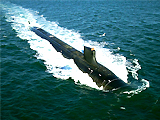Indian Ocean: Ruling the Waves
By Harsh V Pant for ISN
The INS Arihant, as the nuclear submarine is called, will now undergo up to two years of testing and sea trials before being accepted for service by the Indian Navy.
Indian naval expansion is being undertaken with an eye on China, and Arihant notwithstanding, India has nautical miles to go before it can catch up with its powerful neighbor, which has made some significant advances in the waters surrounding India.
Just a few months back, China’s growing naval capability was on full display as it paraded its nuclear-powered submarines for the first time as part of the celebrations to mark the 60th anniversary of the People’s Liberation Army (PLA) navy. Gone is the reticence of yore when China was not ready to even admit that it had such capabilities. Chinese commanders are now openly talking about the need for nuclear submarines to safeguard the nation’s interests, and the Chinese navy, once the weakest of the three services, is now the focus of attention of the military modernization program that is being pursued with utmost seriousness.
China’s navy is now considered the third-largest in the world, behind only the US and Russia and superior to the Indian navy in both qualitative and quantitative terms. The PLA navy has traditionally been a coastal force, and China has had a continental outlook to security. But with a rise in its economic might since the 1980s, Chinese interests have expanded and acquired a maritime orientation with intent to project power into the Indian Ocean.
China is investing far greater resources in the modernization of its armed forces in general and its navy in particular than India seems either willing to undertake or capable of sustaining at present. China’s increasingly sophisticated submarine fleet could eventually be one of the world’s largest, and with a rapid accretion in its capabilities, including submarines, ballistic missiles and GPS-blocking technology, some are suggesting that China will increasingly have the capacity to challenge the US.
Senior Chinese officials have indicated that China would be ready to build an aircraft carrier by the end of the decade as it is seen as being indispensable to protecting Chinese interests in oceans. Such intent to develop carrier capability marks a shift away from devoting the bulk of the PLA’s modernization drive to the goal of capturing Taiwan.
With a rise in China’s economic and political prowess, there has also been a commensurate growth in its profile in the Indian Ocean region. China is acquiring naval bases along the crucial choke-points in the Indian Ocean, not only to serve its economic interests but also to enhance its strategic presence in the region.
China realizes that its maritime strength will give it the strategic leverage that it needs to emerge as the regional hegemon and a potential superpower - and there is enough evidence to suggest that China is comprehensively building up its maritime power in all dimensions.
It is China’s growing dependence on maritime space and resources that is reflected in the country's aspiration to expand its influence and to ultimately dominate the strategic environment of the Indian Ocean region. China’s growing reliance on bases across the Indian Ocean region is a response to its perceived vulnerability, given the logistical constraints that it faces due to the distance of the Indian Ocean waters from its own area of operation.
Yet, China is consolidating power over the South China Sea and the Indian Ocean with an eye on India - something that comes out clearly in a secret memorandum issued by the PLA General Logistic Department director: “We can no longer accept the Indian Ocean as only an ocean of the Indians [...]. We are taking armed conflicts in the region into account.”
Given the immense geographical advantages that India enjoys in the Indian Ocean, China will find it very challenging to exert as much sway in the Indian Ocean as India can. But all the steps that China will take to protect and enhance its interests in the Indian Ocean region will generate apprehensions in India about Beijing’s real intentions, thereby engendering a classic security dilemma between the two Asian giants.
Tensions are inherent in such an evolving strategic relationship as was underlined in an incident earlier this year when an Indian kilo class submarine and Chinese warships, on their way to the Gulf of Aden to patrol the pirate-infested waters, reportedly engaged in rounds of manoeuvring as they tried to test for weaknesses in each others’ sonar systems. The Chinese media reported that its warships forced the Indian submarine to the surface, which was strongly denied by the Indian navy.
Unless managed carefully, the potential for such incidents turning serious in the future remains high, especially as Sino-Indian naval competition is likely to intensify with the Indian and Chinese navies operating far from their shores. The battle to rule the waves in the Indian Ocean may have just begun.

